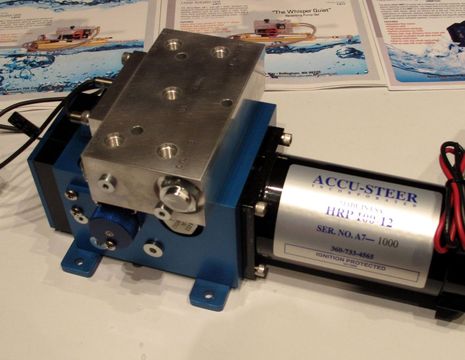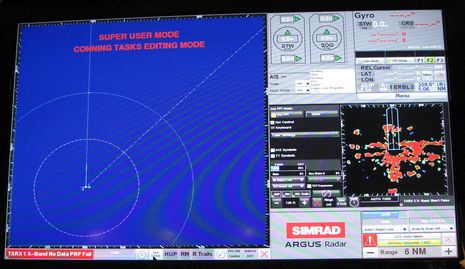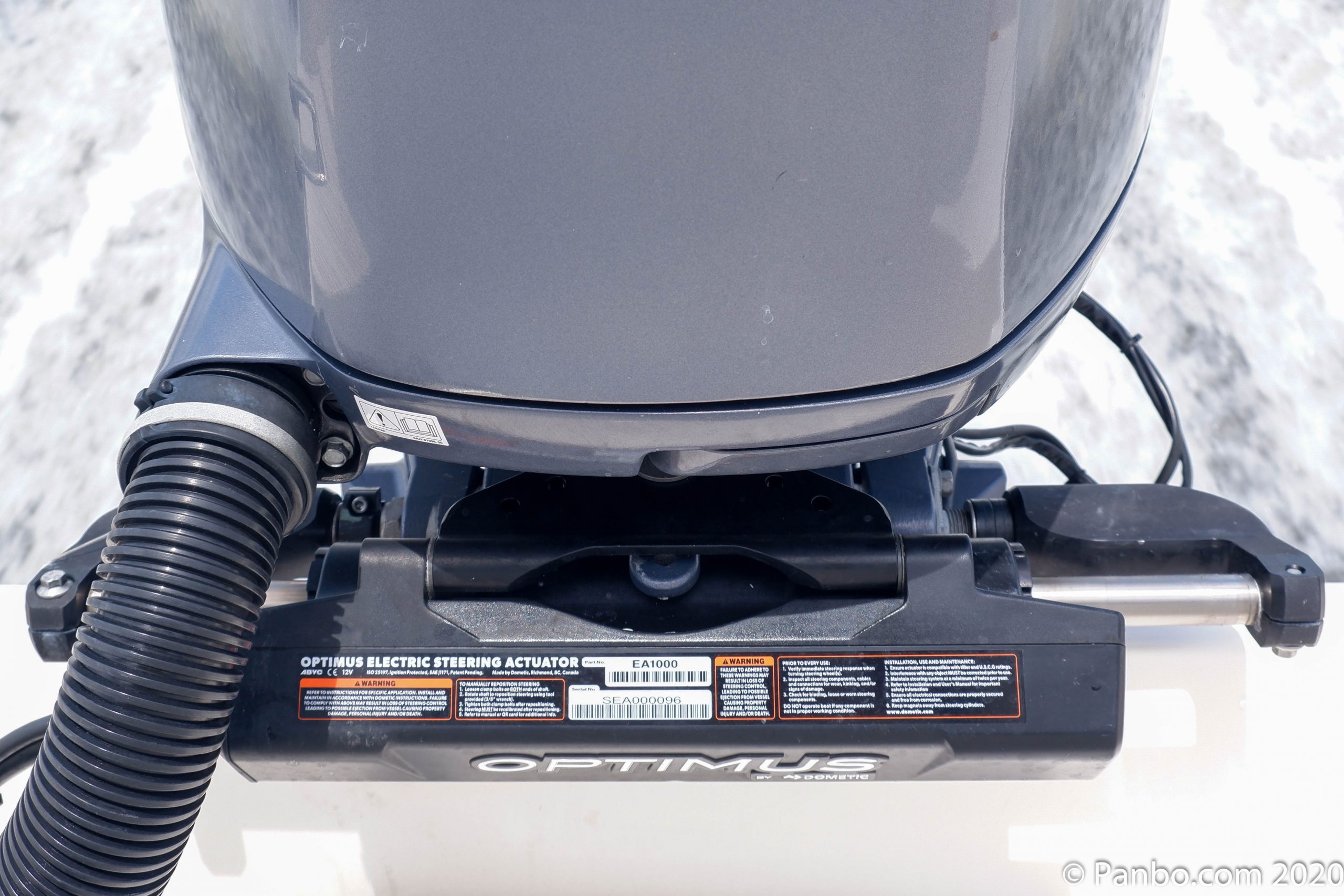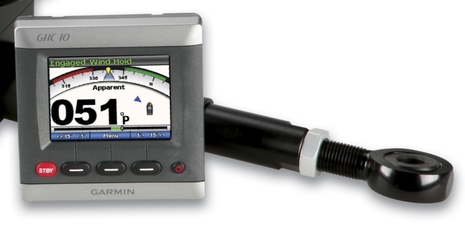NMEA 2011 Expo, neat new stuff #2
Yes that’s an Accu-Steer reversing hydraulic pump meant to push a rudder around, but that block on top is a patent-pending sensor co-developed with FurunoUSA, and the whole package leads to the very interesting “Safe Helm” and “Power Steer” features coming to the latter’s NavPilot 700 (which explains why the pilot came out elsewhere earlier). Safe Helm sounds a lot like the “Shadow Drive” feature so far only seen on the Garmin GHP 10 pilot for hydraulic steering systems; instead of poking a StandBy button, you simply turn the wheel to disengage the pilot and steer around an issue, then let the boat settle on a course again to re-engage. It’s elegantly simple (I’ve tried the Garmin version), and it’s potentially great that it’s is no longer exclusive to one manufacturer. And apparently Furuno’s unique method also means that the pump can be used to power assist a steering system, with numerous controls for how that’s done — like variable assist at different speeds — built into the NavPilot 700…
So here we go with more neat new stuff I saw at the NMEA Expo (part #1 is here). And speaking of autopilots, Simrad introduced the AP70 and 80 professional series along with three different remotes and seven course computers. Unfortunately my photo of the beautiful 5-inch color screens is not worth posting, but the Simrad AP70/80 site will give you some indication. And I did get a reasonable shot of the Argus radar system also being introduced by Simrad Pro. At heart it’s an IMO-approved X-band system able to handle up to four scanners with features like overlaying one set of target imagery over another. But the Anti-Piracy model also lets a ship or superyacht integrate Broadband Radars — which aren’t IMO approved because of their ridiculously low power ratings (the IMO might need a new spec) — for close range surveillance. Hence the Broadband inset on the screen below showing the area right around the stern of ship (that seems to have its butt in a channel)…
Meanwhile the WxWorx division of Baron Services — which notably supplies the data for XM Satellite Weather — introduced new hardware. The WR-10 receiver at left includes a WAAS GPS and can output via USB, Ethernet, or RS-232 serial, and it can deliver XM radio as well as weather. You can accessorize the new receiver and several older models with the new Mobile Link, which will serve the data over WiFi to “soon-to-be available” iPad, iPhone, and Android apps. I gather from the press release (only the aviation versions are online so far) that not all weather data categories are supported by Mobile Link yet, and only WxWorx on the Water will support Baron’s new 2 kilometer sea surface temperatures, at least at first…
At NMEA I was pleased to learn that Icom’s Class B AIS transponder, the MA-500TR we first heard about more than a year ago, is finally FCC approved and shipping. It obviously has its own target tracking screen but also has three NMEA 0183 ports for connections to PCs, MFDs, and radios — it will do auto target calling with certain Icom radios — and it can also handle waypoint navigation. It also seems to be the least expensive Class B with screen (Defender link here) though it appears to be built Icom tough. (I’d still take a long look at the Vesper WatchMate 850 or a Simrad AI-50 if you have Simrad MFDs).
And I’ll close with one more look at the new Fusion Marine Stereo stuff I enthused about last week. I forgot to mention that the 700 Series heads also contain a VHF receiver and you can scan selected channels. Picking those channels and setting the squelch is what’s happening on that iPad, and the results are immediately showing on the IP700 color screen and the NMEA 2000 remote…and could also be showing on an MFD that includes Fusion-Link.


















In 2008 I installed a Furuno NavPilot and since Furuno didn’t sell a hydraulic drive unit they recommended I purchase Accu-Steer which they told me was “very reliable”.
New Morning has two autopilot drive systems for redundancy (only one is used at a time). Both Accu-steer units failed within six months! The cases and hose connections were rusted and corroded and the pumps just sort of withered away unable to move the rams. They very reluctantly replaced the pumps, and the relacements failed within 500 miles! The rams are from Teleflex and were in excellent shape, but the pumps provided by Accu-steer were junk with service to match.
I replaced the entire system with Raymarine course computers (X30), pumps and rams which have worked fine for the last 8,000 miles. And the Raymarine system on my previous boat is now eleven years old, has traveled about 12,000 miles and is also still working perfectly.
Avoid Accusteer.
I believe the entire autopilot system of course computer, pump and ram (if required as in most sailboats) should come from a single vendor who stands behind their product. You’ll know that AccuSteer is a quality product when Furuno puts their logo and warranty behind it. Until then caveat emptor!
“Picking those channels and setting the squelch is what’s happening on that iPod”…
Really, on an iPod?
I meant the iPad in the photo, Karl (I corrected the typo in the entry). And I didn’t mean that the iPad is receiving VHF, though that the big touch screen is great for picking which channels you want to scan on the Fusion IP700.
Raymarine doesn’t actually make their pumps or rams either, though they do put their labels on them, warranty them, and can provide some parts (at a somewhat exorbitant upcharge), though the two parts I have needed for our drives (brushes for the motors and a coil for the clutch valve) have not been able to be supplied by Raymarine as they didn’t have any of the older (2002) parts anymore. The hydraulic portions of Raymarine drives are made by Hy-Pro (http://www.hypro.co.uk/) which has been very helpful in supplying replacement parts for older units, it just takes a while to find them as not all the Raymarine service techs seem to know where to send you when they can’t get the parts. That said, we have been very happy with our two raymarine autopilots which have steered VofJ for well over 20,000 miles if I did my maths right
I have two Accusteer continuous running hydraulic pumps. One is a spare is yet to be used after 20 years.
Accusteer assembles their pumps from industry standard components. Other than their manifold block, I can purchase every component from multiple manufacturers at a hydraulic supply house.
I’ve relocated the Accusteer pump to make room for other equipment and in the process swapped out the gear motor for one with 10% more capacity without ever having to think about whether it would physically fit. Only had to contact the motor manufacturer to ask whether I would be overloading the motor driving two 80 cu. in. steering cylinders (nope).
The boat has gone through several autopilots, and interfacing them to the industry standard reversing solenoids is straight-forward.
Furuno recommends Accusteer for good reasons. Accusteer pump systems live on commercial vessels where reliability is just as critical as repair-ability. Its very hard to get both if one installs equipment that has a run of a few hundred to a thousand units. By using industry standard components, Accusteer takes advantage of millions of unit components in the field.
Finally, of course various hydraulic fitting on my Accusteer units have rusted over the past twenty years. I replaced a few when I changed pumps. All it took was a 5 minute visit to the parts counter at the local hydraulic store………gee whiz, I even got a cup of coffee thrown in.
Was there any mention of some things we’ve been waiting for?
* Airmar CS4500 n2k version
* Airmar PB200 sailboat version
* Navico using the standard PGNs for Class B AIS
Norse, I did talk briefly with Airmar and their focus these days seems to be expanding the CHIRP transducer line and getting the PB200 technology into niches beyond boating. I didn’t ask Navico about the Class B static data PGN but will try to remember at the next shows. First IBEX, then FLIBS!
Norse, I did talk briefly with Airmar and their focus these days seems to be expanding the CHIRP transducer line and getting the PB200 technology into niches beyond boating. I didn’t ask Navico about the Class B static data PGN but will try to remember at the next shows. First IBEX, then FLIBS!
You recommend the Simrad AI50 Class B AIS. Be aware that this unit has NO provision for an external alarm function. Any audible alarm function has to be provided by some other device on the Simnet network. I think this makes it a poor choice as a stand-alone AIS.
Rick, I think that a lot of AIS users have the alarm turned off or minimized because they tend to be more annoying than useful. Simple CPA/TCPA and/or range alarms may be OK offshore, but it takes more parameters and logic to identify true collision threats in the midst of coastal traffic. That’s why I keep beating the drum about Vesper Marine; they’ve been working on sophisticated AIS alarming for a long time and I wish the other manufacturers would take a close look at what they’ve developed.
I’m also hopeful that NMEA 2000 alarming will eventually be the way to go. Individual external alarms are pretty crude. I understand that there is a set of Alarm PGNs that’s quite sophisticated, but they haven’t been published by NMEA yet…so it’s going to take a long time.
I completely agree that most of the existing alarm functions are crude. But being an old, half-deaf, offshore single-handed sailor, and good LOUD alarm is better than nothing.
new cs4500? Not all of Airmar’s pages have been updated to show a new Interface Box which does both NMEA 2000 and 0183. This one does:
http://www.airmartechnology.com/uploads/brochures/CS4500.pdf
It is dated “CS4500_rM 02/03/11”.
Does this mean it might be available to buy soon?
I for one won’t be rushing to buy another CS4500 with or without NMEA 2000. I purchased and installed a CS4500 new in July of 2010. By the time I sailed to the BVI’s in December the water temp sensor stopped working. Search the web and you will find its a common failure. Then when I was sailing to Nuka Hiva in June of 2011 the speed sensor failed – so in total it didn’t last one year. Just one man’s experience but…
Are you sure its the temperature sensor that fails. They are pretty rugged. My own experience is something on the interface electronics board goes for a variety of reasons such as lightning near misses.
Best way to check is to remove the temperature sensor leads from the input and put a 10K ohm resister across the inputs. If the electronics is ok you will read something on the order of 77 degrees F. Same for all electronics providers…..
Airmar puts the same temperature sensor in all of their units, and they seem to make the speed logs/temperature sensor units for all instrument vendors
Cheers
Thanks for the tip Don. When I first tested the temp sensor, I went to the airmar website which has a list of the expected resistance vs temp – I checked it and the reading I had was no where near what it should have been for the temperature I had, so I had assumed a temp sensor failure.
Interestingly Airmar has a ‘what happens if the temp sensor fails on my transducer’ FAQ (link below) and they suggest fitting a new airmar temp sensor as a stand alone unit as a cost effective alternative when the units are out of the two year warranty – I guess this didn’t add to my confidence either! Mine wasn’t out of the warranty time, but crossing the pacific I didn’t feel I could afford the time to send it back, and have the unit itself replaced.
http://faq.airmar.com/index.php?action=artikel&cat=1&id=182&artlang=en
After the speed sensor failed (6 months or so later), and it brought down the raymarine 0183 network until the sensor was disconnected – I wrote off the ultrasonic ‘experiment’. Just recently installed a NMEA2000 backbone, with GWS10 wind sensor and an Airmar DST800 (depth, speed, and temp) sensor and couldn’t be more pleased. So I didn’t mean to condemn airmar as a whole, but feel the technology (ultrasonic) vs. simplicity/reliability argument, admittedly based on my sample of one – favored the simpler solution!
I have been interested in a new Garmin AP because of the Shadow Drive feature but recently heard tha I would not be able to use my existing Robertson pump with the Garmin unit. Now I’m looking at the Furuno AP with Safe Helm. Can anyone tell me if my Robertson pump will work with it!
Sorry, Bob, Furuno Safe Helm is a joint developement with Accu-Steer and only works with their pumps, I’m pretty sure. Have you actually checked with Garmin about your pump?